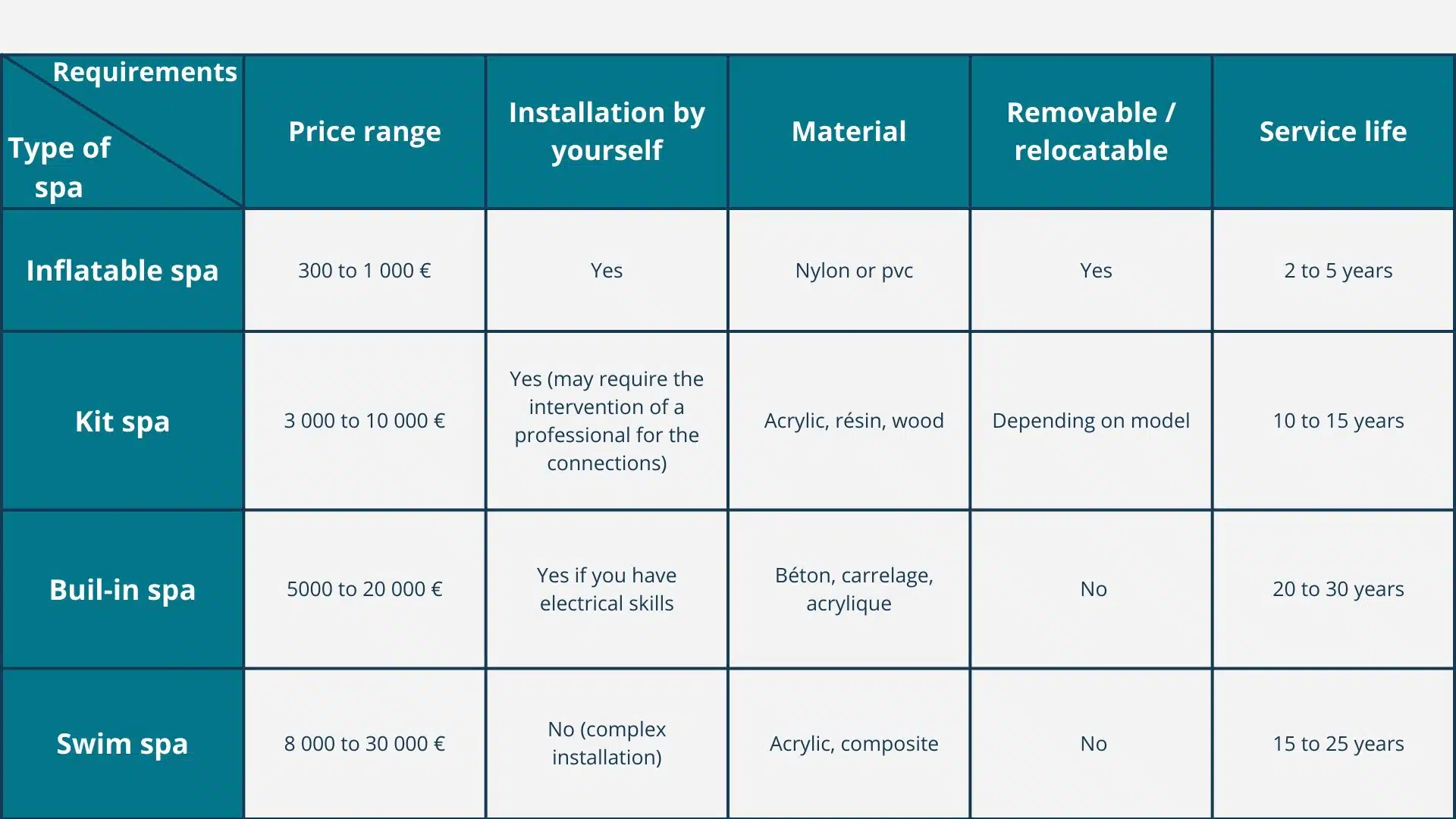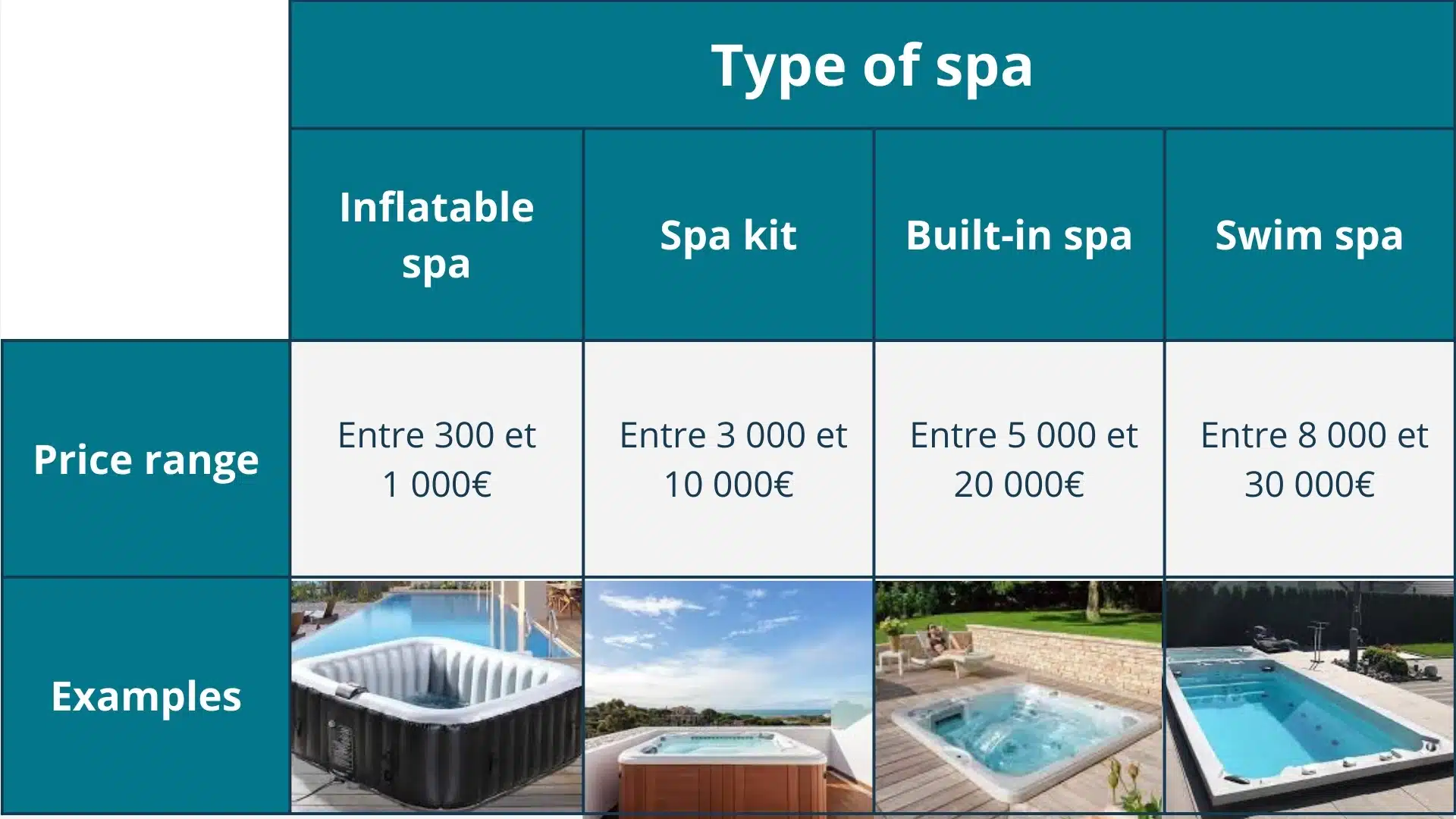Whether you have a garden, a terrace or a room dedicated to well-being in your home, a spa is the ideal tool for relaxing at home without having to move.
After a session of sport or a hard day's work, a spa session is bound to be beneficial, thanks in particular to the many benefits it has to offer. benefits on the body and mind. Would you like to install a spa in your home, but don't know where to start?
To help you choose the ideal spa to suit all your needs, this article gives you our advice on various criteria to consider, such as location, equipment and budget.

Pour choisir le spa qui vous convient, vous devez évaluer l’espace disponible, identifier vos envies et votre budget. Vous devez également prendre en compte les différents types de spas existants sur le marché.
Before buying your spa, it's important to ask yourself a few essential questions to ensure that it functions properly and lasts as long as you need it to.
Ces critères impacteront les prix d’achat de votre spa. Cependant, ils ne sont pas à négliger afin d’assurer votre confort et votre sécurité.
To help you decide on the ideal location for your spa, here are the advantages and disadvantages of each option.
Benefits :
Disadvantages:
Benefits :
Disadvantages :
Choisissez parmi plusieurs types de spas en fonction de votre budget.

Between €300 and €1,000. Prices vary according to materials, size and accessories. This is the cheapest solution, and installation is easy (no major work required). Made from nylon or PVC, it can be dismantled and moved. It does, however, have a shorter lifespan.
Entre 3000 et 10 000 euros. Prix abordable, son installation est relativement facile. Dimensions standard. L’intervention d’un professionnel peut être nécessaire pour les raccordements (eau, électricité). Avant de commencer l’installation, demandez à un professionnel de vérifier la stabilité du sol (terrain) ou la solidité de la terrasse. Respectez également les normes électriques essentielles pour l’installation du spa.
De 5000 à 20000 euros. Sans bords apparents, le spa encastrable peut être fabriqué sur-mesure. Vous pouvez l’installer vous-même (avec des connaissances en électricité). Le prix d’un spa extérieur est plus élevé, et son installation nécessite l’intervention d’un professionnel. Vous pouvez également faire appel à un professionnel (comptez un tarif horaire de 50 à 80 euros).
Le prix d’un spa extérieur est plus élevé, et son installation nécessite l’intervention d’un professionnel.
Between 8,000 and 30,000 euros. It is equipped with a counter-current swimming system. Some are very large, with 2 pools: one for swimming and another for relaxation.
To ensure that it runs smoothly and provides the perfect moment of relaxation, a spa has a number of features to meet all your needs, including several jets, a heating system and a filtration system. Treating the water in your spa is also essential. You'll find summary information on each element below. To find out more, read our detailed article on spa equipment
Il existe plusieurs types de jets pour les spas, chacun répondant à un besoin particulier. Qu’ils soient à base d’eau ou d’air, ils sont conçus pour vous relaxer immédiatement. Attention, tous les jets ne sont pas disponibles pour tous les spas. Certains d’entre eux nécessitent une utilisation en extérieur ou intérieur.
Choosing the type of heater for your spa is a very important step, as it has a direct influence on energy efficiency, comfort of use and long-term costs. You'll need to choose between a heat exchange spa or an electrically heated spa.
A spa's filtration system is essential for keeping the water clean, preserving the longevity of the equipment and providing a pleasant, hygienic bathing experience. There are several types of filtration system used in spas: pressure filtration, permanent filtration and surface filtration.
L’analyse de l’eau dans un spa est essentielle pour maintenir une qualité optimale en mesurant des paramètres comme le pH, l’alcalinité, et les niveaux de désinfectants. Un traitement régulier de l’eau à l’aide de produits adaptés permet d’équilibrer ces paramètres et d’éviter la prolifération de bactéries. Cela garantira ainsi une expérience saine et sécurisée pour les utilisateurs.
To give you an idea of your total budget, you'll need to take into account the cost of the initial purchase (with or without work, installation, delivery, equipment and accessories) and the cost of use (maintenance, filter cartridges, treatment products, energy and water consumption). Maintaining a spa involves cleaning, filtering and treating the water.
The cost of buying a spa will depend mainly on the type of spa you want, its materials and equipment, and its size (number of seats). Here's a table showing the different spas on the market and their prices:

The cost of using a spa can vary considerably depending on a number of key factors, such as electricity consumption, water consumption and water treatment and analysis.
A spa's electricity consumption varies according to the type of spa (inflatable, above-ground, in-ground), the size of the spa, its equipment (heating, filtration) and how often it is used. On average, a 4-person spa will use between 2,500 and 7,500 kWh per year. To find out more about how to reduce your electricity bill, read our blog post on the subject.
Depending on the size of your spa, it will consume around 6,000 litres of water a year. The amount of water your spa consumes each year will depend on its capacity and the number of times you fill it with water. The efficiency of the filtration system is essential, as is water quality control.
Water analysis is a crucial step in ensuring optimum quality in your spa. It involves measuring key parameters such as pH, alkalinity and disinfectant levels (such as chlorine or bromine). Depending on the test results, adjustments need to be made using appropriate chemicals. ICO Spa, analyseur d’eau connecté. Il analyse 1 fois/heure la qualité de l’eau et envoie des recommandations appropriées sur les produits de traitement à ajouter dans votre spa.
Choosing a spa is an investment that can transform your living space into a haven of relaxation and well-being. By taking essential criteria into account, you can find the ideal model to meet your specific needs. Whether you opt for an inflatable, built-in or swim spa, it's important to assess your budget and consider the long-term maintenance costs. A well-considered choice will enable you to enjoy the full benefits of a spa in the comfort of your own home.